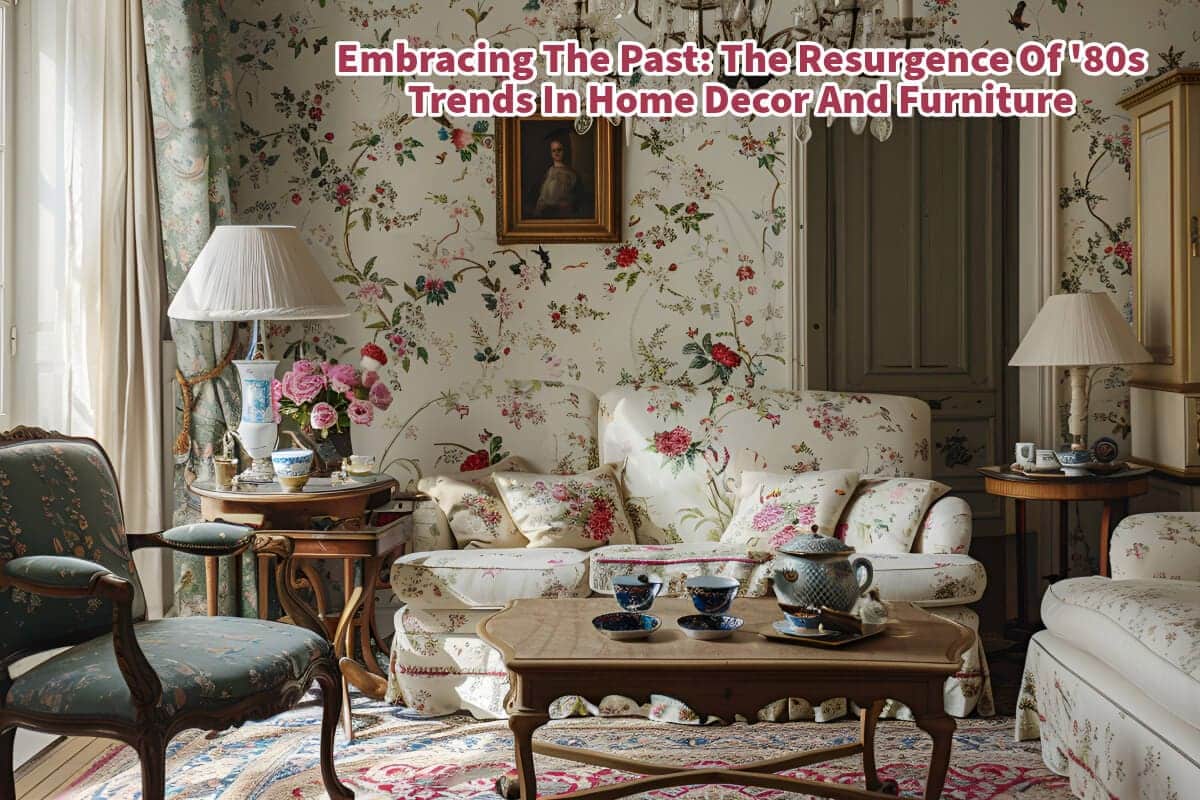Trends in fashion and design are cyclical. They often revisit the aesthetics of previous decades with a fresh perspective. If you are around long enough, you will start to see these cycles return again and again.
Recently, there’s been a noticeable shift back to the bold and vibrant styles of the 1980s in the realm of home decor and furniture. This revival brings a nostalgic blend of the era’s characteristic flair and modern sensibilities, making it an exciting time for interior design enthusiasts. This post will explore the defining elements of ’80s interior design and how they return to today’s homes.
Table of Contents
- Retro Revival: The Return Of 1980s Interior Design Trends In Modern Homes
- All-American Aesthetic:
- Bold Colors And Curvy Shapes
- Floral And Natural Motifs
- Tropical And Animal Prints
- Memorable Material And Texture Mixes
- Technological Influences
- Resurgence Of ’80s Color Palettes:
- Listen To Our Podcast About Why Are ’80s Trends Making a Comeback in Home Decor? Below or By clicking here.
- Related Content
Retro Revival: The Return Of 1980s Interior Design Trends In Modern Homes
As history often repeats itself, so do trends in fashion and design. The vibrant and eclectic styles of the 1980s have once again captured the imagination of home decorators and designers.
This resurgence reintroduces the era’s dynamic and unique aesthetics into contemporary settings, blending nostalgia with modernity. Let’s delve into some notable ’80s interior design trends that are returning to our homes.
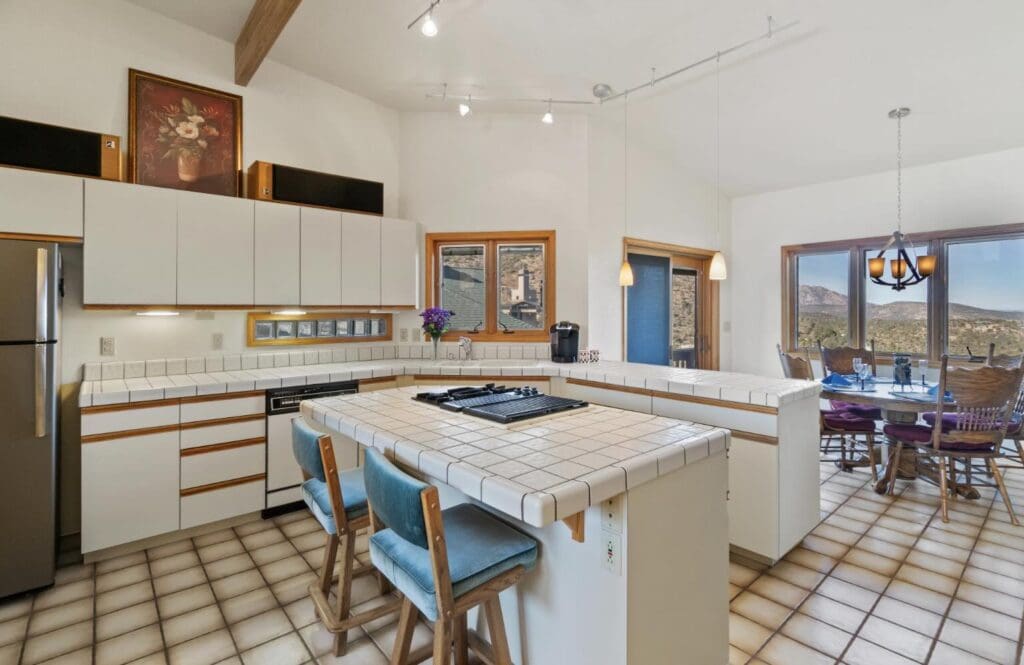
All-American Aesthetic:
In the 1980s, brands like Bob Timberlake epitomized the All-American decor trend, featuring furniture that embraced a lived-in, distressed look. This style highlighted imperfections as a form of beauty, promoting a sense of comfort and nostalgia.
Timberlake’s designs, deeply rooted in Americana, often incorporated elements from American landscapes and everyday scenes, capturing the essence of American life. Today, this trend is resurfacing, not just in distressed furniture but also through reclaimed materials and revamped classic American motifs, adding a contemporary twist to the traditional.
Bold Colors And Curvy Shapes
The ’80s were notorious for their bold color palettes and curvy, dynamic shapes, which are once again gaining popularity in interior design. Notably, the color “Bay Blue,” reminiscent of a serene Norwegian blue, has been highlighted by brands like Minwax and Krylon as a trendy color.
This hue represents a shift towards a cozier, more traditional approach to home aesthetics, bridging modern simplicity with rich, vibrant tones. Today’s incorporation of ’80s colors combines modern design elements to create inviting and bold spaces.
Floral And Natural Motifs
The 1980s were not only about bold colors and distressed furniture; they also celebrated nature through intricate floral patterns and tropical designs.
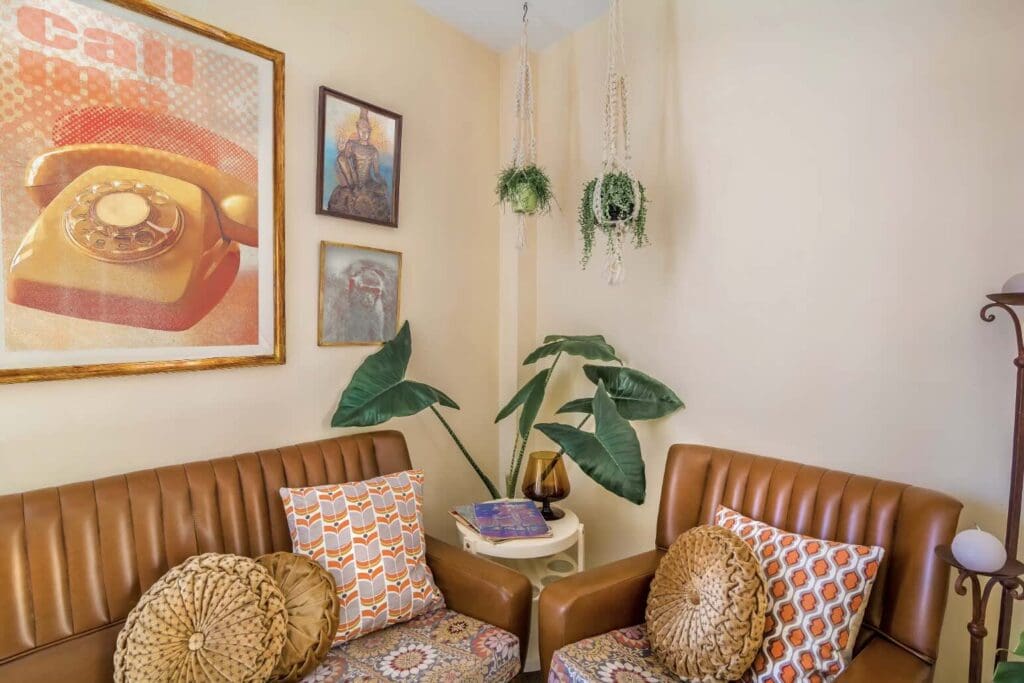
A quintessential example of this trend is Laura Ashley’s designs, which became synonymous with the era’s penchant for floral prints. Laura Ashley’s fabrics and wallpapers featured delicate roses, peonies, and other floral imagery that evoked an English countryside, bringing a soft, romantic essence into the home.
This floral trend is experiencing a revival, with modern interpretations focusing on large-scale floral patterns and vibrant, contrasting colors.
Tropical And Animal Prints
Alongside florals, the ’80s also embraced the exotic and the wild, with interior designs featuring tropical leaves, fauna, and animal prints. These elements were often incorporated into bold wallpapers, upholstery, and accent pieces, creating a statement of luxury and escapism.

Today, tropical motifs are being reintroduced with a fresh perspective, using more subdued tones and mixed with minimalist decor to balance the boldness. Similarly, animal prints return with modernized patterns and colors that integrate seamlessly into contemporary aesthetics.
Memorable Material And Texture Mixes
The decade was also known for its adventurous mix of materials and textures, including glass block walls, mirrored surfaces, and the extensive use of velvet and chintz. These materials are returning, and contemporary designers are finding new ways to integrate them into modern decor.
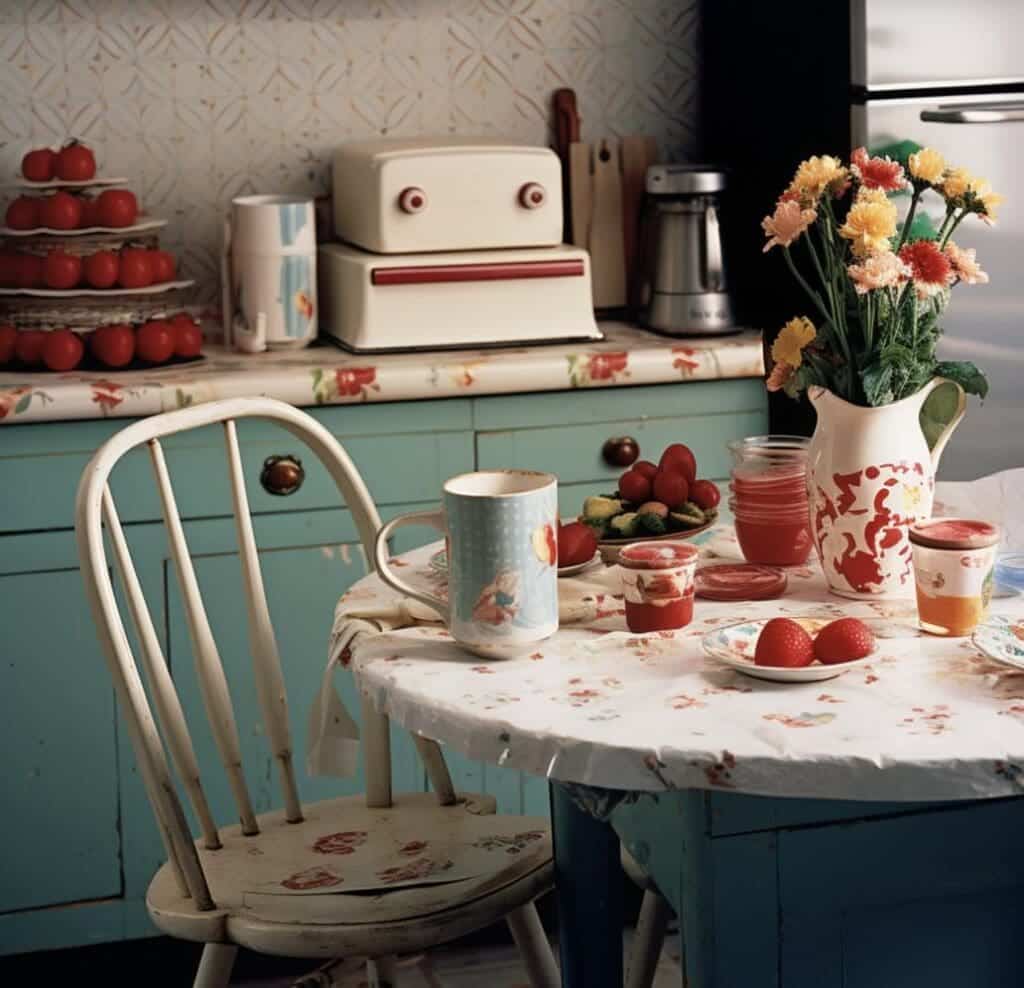
Mirrored surfaces are used more judiciously to add depth and light to rooms, while velvet is seen in more affluent, deeper tones that align with current color trends.
Technological Influences
The ’80s fascination with technology and futurism can be seen in the streamlined and glossy finishes that are popular again today. Metallic accents and high-gloss finishes are being used to give a sleek, futuristic look that nods to ’80s innovation and optimism about the future.
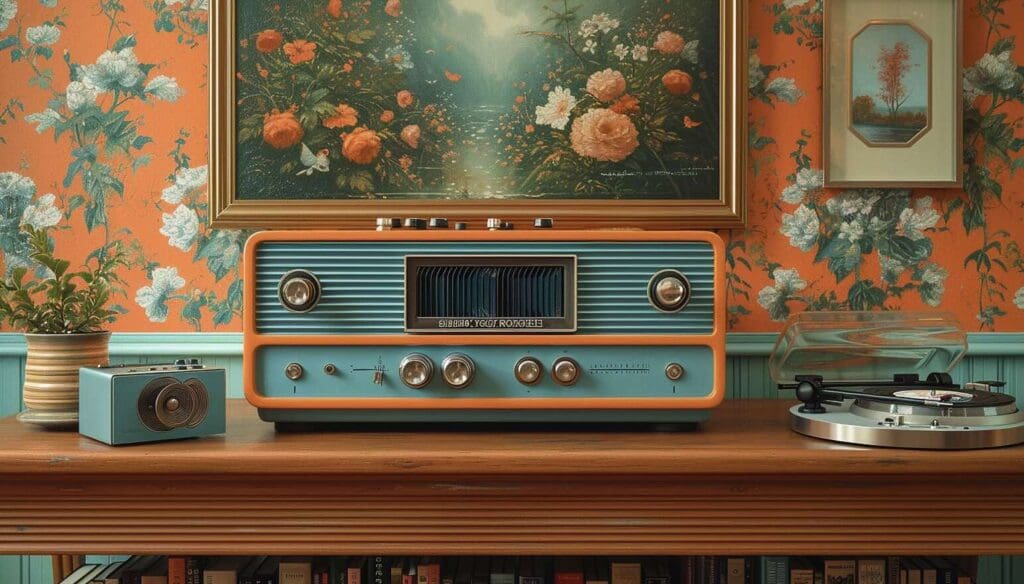
Today, we see renewed interest in this as we look for technological interest in our designs. As we all understand, AI and its power are here to stay, so we need to learn to embrace it.
Resurgence Of ’80s Color Palettes:
The 1980s were not just a time of bold blues and vibrant contrasts; the decade also embraced a spectrum of earth tones, making a solid comeback in today’s interior design trends.
Shades of brown and green, prevalent in ’80s home decor, are now being reintroduced into modern homes, offering warmth and natural elegance. These colors were often seen in wood paneling, plush sofas, and textured wallpapers, creating cozy environments that felt inviting and stylish.
Today, these earthy hues are being used more subtly and refinedly. Designers use softer shades of green and warm, rich browns to craft serene and grounding spaces.
These colors work beautifully with natural materials like wood, leather, and linen, bringing a tactile quality to interiors that echoes the ’80s love for texture and comfort. The integration of these colors is also seen in accessories and accent pieces, allowing for depth and layering in interior compositions.
By revisiting these quintessential ’80s colors, contemporary design pays homage to the past and adopts its best elements, reinterpreting them with a modern twist to fit today’s aesthetic and functional needs. This color revival is a testament to the enduring appeal of the ’80s design ethos, characterized by its boldness and innovation in color and material.
As we continue to explore and reinterpret ’80s design elements, it’s clear that the decade’s influence is more than a passing trend. It’s a vibrant, ongoing conversation between the past and present, enriching our living spaces with comfort, nostalgia, and modern flair.
Listen To Our Podcast About Why Are ’80s Trends Making a Comeback in Home Decor? Below or By clicking here.
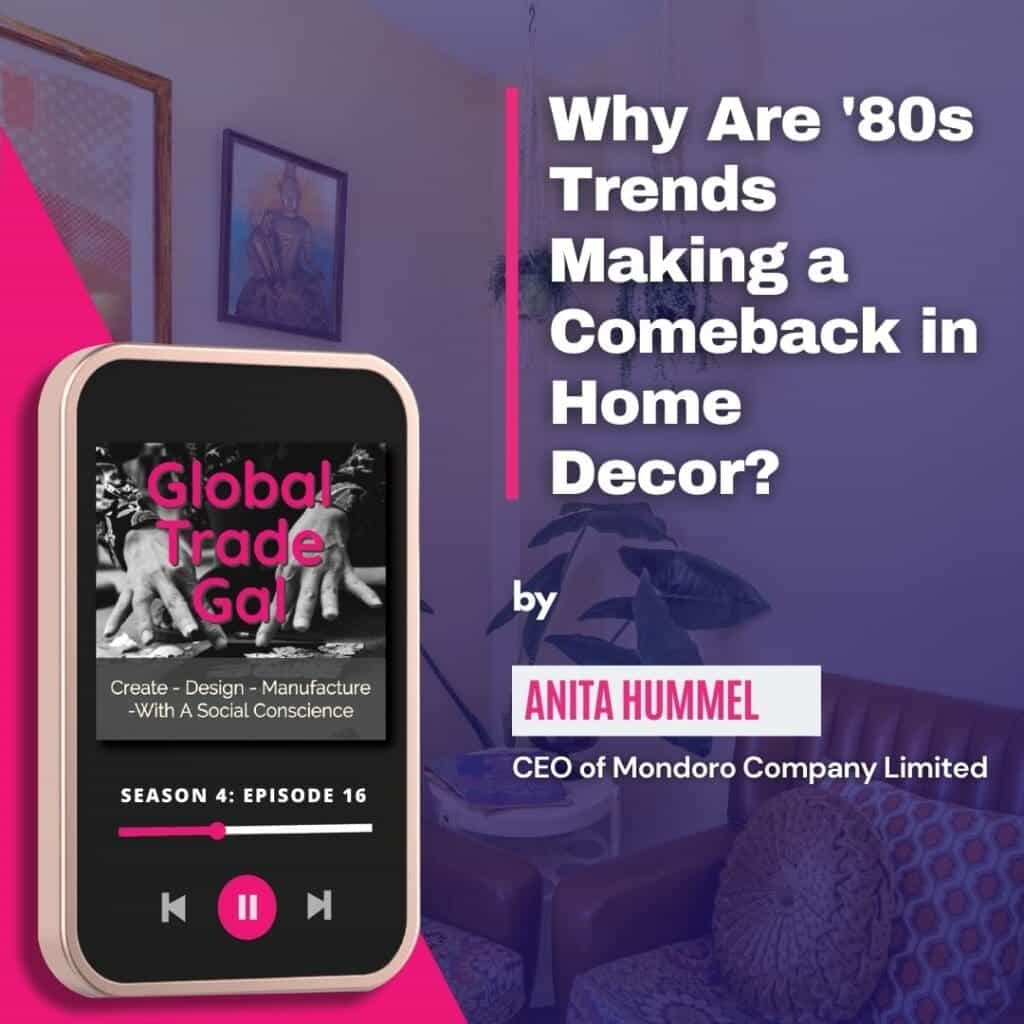
If you are interested in seeing how Mondoro can help you with your handmade home decor products – we would love to talk to you about how we can help you.
Find out more about how Mondoro can help you create, develop, and manufacture excellent home decor and home furniture products – including lacquer furniture. Don’t hesitate to contact me, Anita. Check out my email by clicking here or become a part of our community and join our newsletter by clicking here.
Mondoro gives out a FREE Lookbook to anyone interested. You can receive a copy of our latest Lookbook by clicking here.
Listen to our Podcast called Global Trade Gal. You can find it on all major podcast platforms. Try out listening to one of our podcasts by clicking here.
Subscribe to our Mondoro Company Limited YouTube Channel filled with great videos and information by clicking here.
Related Content
12 Living Room Home Decor Wall Ideas For Your Empty Walls
Scandia’s furniture design, designer aesthetics, and philosophies have remained influential since its emergence in the 20th century. The critical focus of Scandia’s design lies in the harmonious blend of form and function, ensuring that beautiful products are not merely eye candy but also practical for everyday use.
You can learn more by reading our blog, 12 Living Room Home Decor Wall Ideas For Your Empty Walls by clicking here.
Scandia Design Furniture And Designers: Pioneers Of Simplicity
Scandia’s furniture design, designer aesthetics, and philosophies have remained influential since its emergence in the 20th century. The critical focus of Scandia’s design lies in the harmonious blend of form and function, ensuring that beautiful products are not merely eye candy but also practical for everyday use.
To learn more, you can read Scandia Design Furniture And Designers: Pioneers Of Simplicity by clicking here.
Wabi-Sabi: Embracing Imperfection And Transience In Design
In an era where everything is mass-produced to perfection, where symmetry is celebrated, and where glossy, flawless finishes are the norm, the ancient Japanese design philosophy of Wabi-Sabi offers a breath of fresh air. Instead of striving for perfection, Wabi-Sabi celebrates imperfection and sees beauty in the simple, rustic, and imperfect life and design choices.
You can discover more by reading Wabi-Sabi: Embracing Imperfection And Transience In Design by clicking here.

